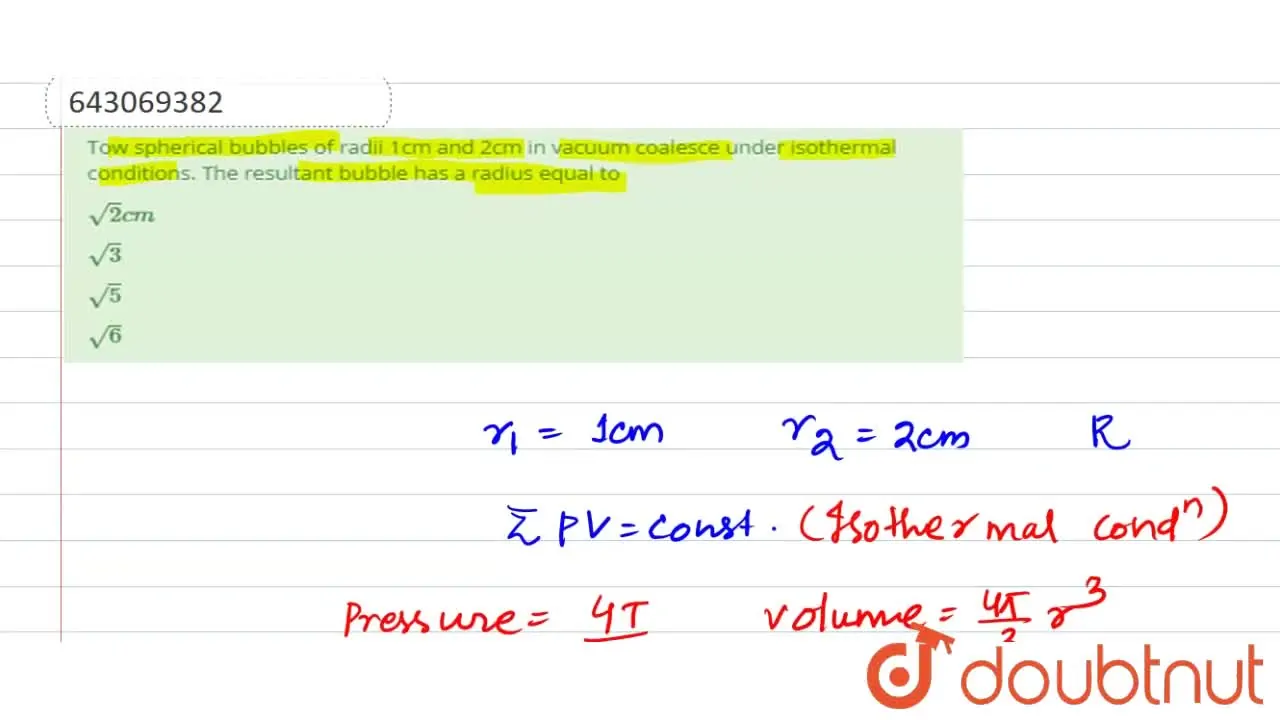Tow spherical bubbles of radii 1cm and 2cm in vacuum coalesce under isothermal conditions. The resultant bubble has a radius equal toSolution in Odia
√2cm
√3
√5
√6
The correct Answer is:C
Step by step video, text & image solution for Tow spherical bubbles of radii 1cm and 2cm in vacuum coalesce under isothermal conditions. The resultant bubble has a radius equal to by Physics experts to help you in doubts & scoring excellent marks in Class 12 exams.
Related Playlists
Similar Questions
The universal property of all substances is :
04:28View SolutionWhat Is the maximum velocity with which alcohol density 0.8gm/cc and coefficient of viscosity 0.012 poise can flow through a tube of 1 mm radius without turbulent being produced? R=1000
02:20View SolutionTwo spherical soap bubbles of radii r_1 and r_2 in vacuume collapse under isothermal condition. The resulting bubble has radius R such that
03:05View SolutionA soap bubble in vacuum has a radius of 3 cm ad another soap bubble in vacuum has a radius of 4 cm. if the two bubbles coalesce under isothermal condition, then the radius of the new bubble is
03:20View SolutionA soap bubble in vacuum has a radius of 3 cm and another soap bubble in vacuum has a radius of 4 cm . If the two bubbles coalesce under isothermal conditions then the radius of the new bubble is :
02:54View SolutionTwo spherical soap bubbles of radii a and b in vacuum coalesce under isothermal conditions. The resulting bubble has a radius given by
04:08View SolutionTwo spherical soap bubbles of a radii 1 cm and 2 cm vacuum coalesce under isothermal conditions . The resultant bubble has a radius of
03:11View SolutionA soap bubble in vacuum has a radius of 3cm & another soap bubble in vacuum has a radius of 4 cm if the 2 bubbles coalesce under isothermal conditions then what is radius of the new bubble ?
02:14View SolutionTwo spherical soap bubbles of radii r_(1) and r_(2) in vacuum combine under isothermal conditions. The resulting bubbles has a radius equal to
02:14View SolutionTwo spherical soap bubbles of radii a and b in vacuum coalesce under isothermal condition. The resulting bubbles has a radius given by …..
View SolutionTwo spherical soap bubbles of radii a and b in vacuum coalesce under isothermal condition. The resulting bubbles has a radius given by …..
05:10View SolutionTwo spherical soap bubbles of radii a and b in vacuum coalesce under isothermal conditions. The resulting bubbles has a radius given by
04:49View SolutionTwo spherical soap bubbles of radii r_1 and r_2 in vacuume coalesce under isothermal condition. The resulting bubble has radius R such that
08:44View SolutionA soap bubble in vacuum has a radius of 3 cm and another soap bubble in vacuum has a radius of 4 cm . If the two bubbles coalesce under isothermal conditions then the radius of the new bubble is :
02:51View SolutionTwo spherical soap bubbles of radii r1 and r2 in vacuume coalesce under isothermal condition. The resulting bubble has radius R such that
View Solution


